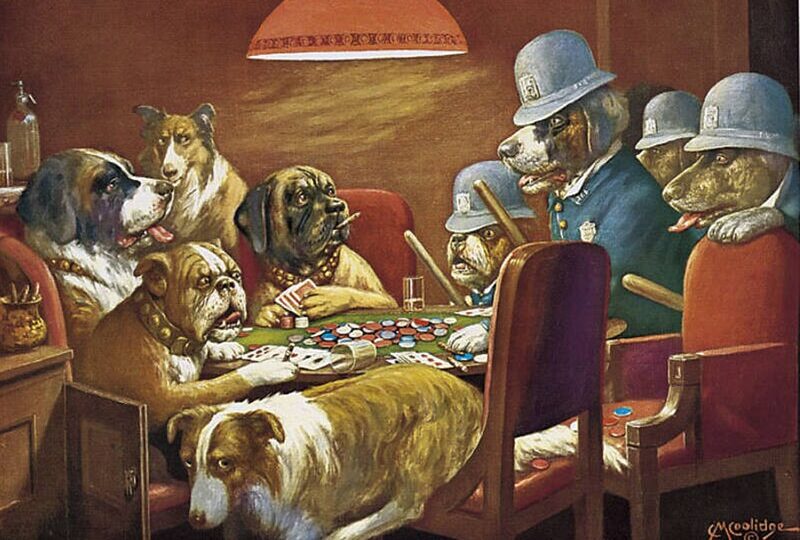Many people are familiar with the classic paintings of Dogs Playing Poker by Cassius Marcellus Coolidge. Featuring humanised dogs in comic situations, these famous dog paintings were thought to have been initially created in 1894 by the artist and were commissioned by Brown & Bigelow for cigar ads in 1903.
It is generally agreed that the technique and style of these vintage paintings, executed in oils on canvas, were meant to be reminiscent of 19th-century Western art. But, in fact, the paintings are eminently recognizable and well-known to the point that they’ve become a cultural reference in the history of American art.
But where did these fascinating artworks draw inspiration from? How did C.M. Coolidge’s paintings of American dogs playing cards end up charmed and amusing art lovers of all walks? This article tracks these paintings’ journey to their current state of fame.
Poker Game (1894)
The first in the series of 18 oil paintings by Cassius Marcellus Coolidge, “Poker game,” aptly captures the irreverent spirit of our canine friends as they raise their cards during a game — likely for higher stakes than we would like to imagine. Coolidge’s tongue-in-cheek sense of humour and the mischievous facial expressions on the dogs in this painting make it one of the most famous dog paintings in history.
The action-packed painting depicts four canine card players around a game of poker: one dapper golden retriever, a St. bernard with one eye on his cards and the other peeking outside the frame, a bulldog smoking pipe with great interest in his cards, and a Labrador depicting an expression that looks like a winner’s. In addition, the painting contains elements still common in the modern poker culture, such as a beer barrel, ashtray, and a bottle of liquor with a paper bag.
A Friend in Need (1903)
“A Friend in Need” depicts seven dogs around a card table playing poker, smoking cigars, drinking alcoholic beverages, and gambling. The magic trick to this canine oil painting is that it’s both whimsical and relatable—two traits that we humans share with our fur friends. Through their facial expressions and gestures, Coolidge captured the humour and humanity of dogs mid-game with furrowed brows and intense concentration.
What’s more, ‘A friend in need’ depicts a mix of realism, caricature, and cultural iconography that makes it unique to art history. Symbolism, a significant theme in Dogs Playing Poker, was an aspiring 19th-century style of Romanticism that was an attempt to awaken the audience’s imagination. Plus, this adorable portrait shows off our pets’ personalities, ranging from reserved to mischievous.
It is believed that Coolidge drew inspiration from English artist Sir Edwin Landseer’s painting Laying Down the Law (1840). While the pictures have similar themes, Coolidge’s portrayed a more lighthearted and comical spirit than Landseer’s more severe and solemn tone.
A Bold Bluff (1903)
While C.M. Coolidge’s collection of ‘Dogs Playing Poker’ is often perceived as satirical, it also represents the allegory of life pictured through a pair of paintings. “The Bold Bluff,” painted in 1903, depicts a Saint Bernard holding two deuces and betting against four other dogs. His opponents wonder if he has gotten away with something very clever or if he is the biggest fool at the table.
What makes the dogs in paintings extraordinary is that the artist has pictured the expressions with masterful use of colours and brushstrokes: from the confident straight head of Saint Bernard to the anxious hand wringing of his opponent, every gesture and nuance is beautifully captured—making it one of the most pretty dog paintings you’ve ever seen!
A Waterloo (1903)
Playing poker takes courage, and a dog has enough to play any hand – as Coolidge’s painting ‘A Waterloo’ shows. Finished the same year as ‘A Bold Bluff,’ this masterpiece depicts St. Bernard’s talent for the art of poker. As his fellow canines watch on in stunned amusement, the deck is flipped over to reveal the winning hand—a pair of lowly deuces. An accurate representation of the luck of the draw, Coolidge captures the very moment when a well-played bluff or considerable risk pays off.
Painted with a masterful eye for detail, the famous art with dogs depicts a couple of perplexed bulldogs at the centre-right and another one just off the table who celebrates the dog’s win. The painting uses colour and shape to create a dynamic representation of this remarkable poker moment!
Sitting up with a Sick Friend (1903)
Sitting up with a Sick Friend features six dogs sitting next to one another on a round table, watching over their ailing friend. The central figure is an elderly bulldog whose furrowed brow and downturned mouth convey his ailment. Yet he pushes on and plays poker while surrounded by his faithful friends! When the fellow pups aren’t tossing money into the pot or keeping a handle on their cards, they are checking in on their sick companion – to make sure he has everything he needs to be comfortable.
Using familiar objects like poker cards and poker chips, C.M. Coolidge created a painting that embodies the American spirit of comfort and familiarity. While the piece can be interpreted as a symbol of friendship and how people come together in times of need and difficulty, it can also be interpreted as an emblem for how winning a poker hand can help you get by in life.
Conclusion
Cassius Marcellus Coolidge was regarded as “the father of American puppy art” because of his famous depictions of anthropomorphic dogs playing poker. He remains one of the most beloved figurative painters in American art history due to the humour, genuine humanity, and self-awareness that saturates his work.













